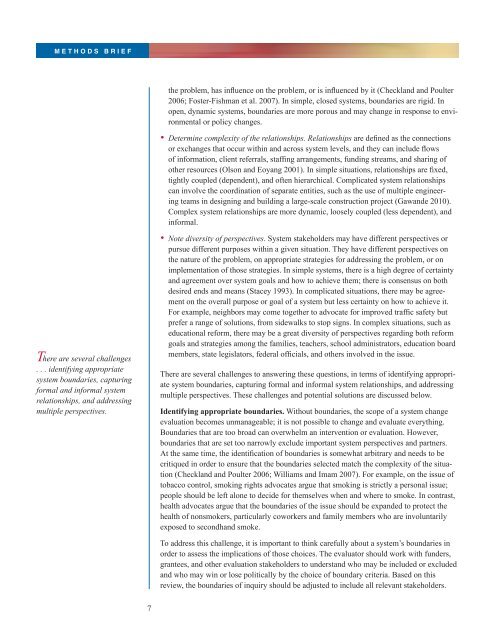Evaluating System Change - Mathematica Policy Research
Evaluating System Change - Mathematica Policy Research
Evaluating System Change - Mathematica Policy Research
You also want an ePaper? Increase the reach of your titles
YUMPU automatically turns print PDFs into web optimized ePapers that Google loves.
M E T H O D S B R I E F<br />
There are several challenges<br />
. . . identifying appropriate<br />
system boundaries, capturing<br />
formal and informal system<br />
relationships, and addressing<br />
multiple perspectives.<br />
7<br />
the problem, has influence on the problem, or is influenced by it (Checkland and Poulter<br />
2006; Foster-Fishman et al. 2007). In simple, closed systems, boundaries are rigid. In<br />
open, dynamic systems, boundaries are more porous and may change in response to environmental<br />
or policy changes.<br />
• Determine complexity of the relationships. Relationships are defined as the connections<br />
or exchanges that occur within and across system levels, and they can include flows<br />
of information, client referrals, staffing arrangements, funding streams, and sharing of<br />
other resources (Olson and Eoyang 2001). In simple situations, relationships are fixed,<br />
tightly coupled (dependent), and often hierarchical. Complicated system relationships<br />
can involve the coordination of separate entities, such as the use of multiple engineering<br />
teams in designing and building a large-scale construction project (Gawande 2010).<br />
Complex system relationships are more dynamic, loosely coupled (less dependent), and<br />
informal.<br />
• Note diversity of perspectives. <strong>System</strong> stakeholders may have different perspectives or<br />
pursue different purposes within a given situation. They have different perspectives on<br />
the nature of the problem, on appropriate strategies for addressing the problem, or on<br />
implementation of those strategies. In simple systems, there is a high degree of certainty<br />
and agreement over system goals and how to achieve them; there is consensus on both<br />
desired ends and means (Stacey 1993). In complicated situations, there may be agreement<br />
on the overall purpose or goal of a system but less certainty on how to achieve it.<br />
For example, neighbors may come together to advocate for improved traffic safety but<br />
prefer a range of solutions, from sidewalks to stop signs. In complex situations, such as<br />
educational reform, there may be a great diversity of perspectives regarding both reform<br />
goals and strategies among the families, teachers, school administrators, education board<br />
members, state legislators, federal officials, and others involved in the issue.<br />
There are several challenges to answering these questions, in terms of identifying appropriate<br />
system boundaries, capturing formal and informal system relationships, and addressing<br />
multiple perspectives. These challenges and potential solutions are discussed below.<br />
Identifying appropriate boundaries. Without boundaries, the scope of a system change<br />
evaluation becomes unmanageable; it is not possible to change and evaluate everything.<br />
Boundaries that are too broad can overwhelm an intervention or evaluation. However,<br />
boundaries that are set too narrowly exclude important system perspectives and partners.<br />
At the same time, the identification of boundaries is somewhat arbitrary and needs to be<br />
critiqued in order to ensure that the boundaries selected match the complexity of the situation<br />
(Checkland and Poulter 2006; Williams and Imam 2007). For example, on the issue of<br />
tobacco control, smoking rights advocates argue that smoking is strictly a personal issue;<br />
people should be left alone to decide for themselves when and where to smoke. In contrast,<br />
health advocates argue that the boundaries of the issue should be expanded to protect the<br />
health of nonsmokers, particularly coworkers and family members who are involuntarily<br />
exposed to secondhand smoke.<br />
To address this challenge, it is important to think carefully about a system’s boundaries in<br />
order to assess the implications of those choices. The evaluator should work with funders,<br />
grantees, and other evaluation stakeholders to understand who may be included or excluded<br />
and who may win or lose politically by the choice of boundary criteria. Based on this<br />
review, the boundaries of inquiry should be adjusted to include all relevant stakeholders.
















